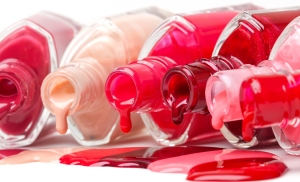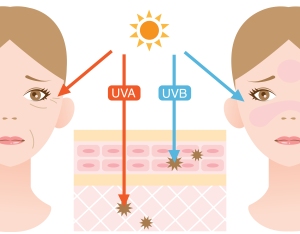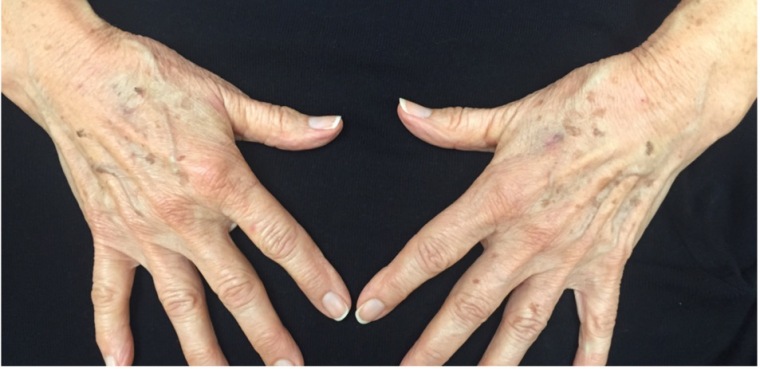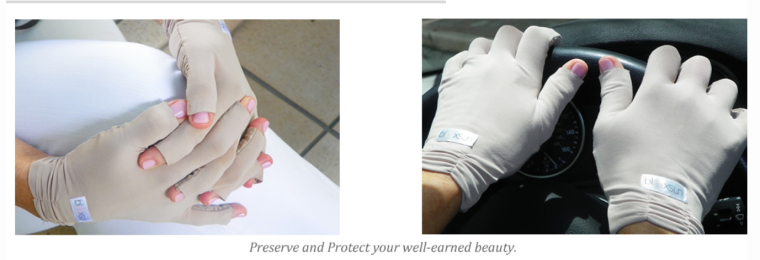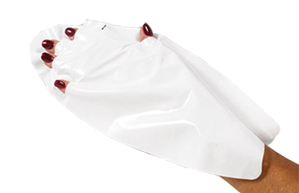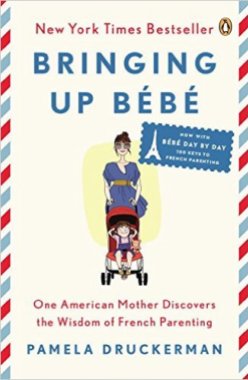
Can you use diet to help prevent against skin cancer?
The answer is No.
And Yes.
The reason why I say “no” first is that there are no superfoods in the world that can fully protect against any cancers, and NOTHING replaces sun-safe behavior as the single most effective strategy against skin cancer. We are all looking to take back some control against the scariness and sometimes unfair nature of cancer. Diet can seem like the most obvious choice, but let’s not let diet overshadow the most important factors in preventing skin cancer, in this order:
- Sun protection
- Sun protection
- Sun protection
- #4 through #100 – Sun protection

The use of sunscreen, sun clothes, sunglasses, wide brimmed hats, and seeking shade is far more important than what you eat. Over 80% of skin cancers are due to UV radiation. Just like quitting smoking is one of the best things you can do to prevent lung cancer and heart disease, sun protective measures will always trump nutrition as a cancer prevention strategy.
Now why, “yes?”
I’m fascinated by how our nutrition might affect the overall health of our body. Apparently, so are a lot of other people. You can find a nutrition study for just about any nutrient, and just about any disease state. After reading Michael Pollan’s In Defense of Food, I now understand how difficult it is to isolate a single nutrient with regards to health, since nutrition does not exist in a vacuum. Nutrition is much more than the sum of its nutrient parts. It depends on the human host that consumes it, vitamins and cofactors consumed simultaneously, the soil/environment in which it was grown, etc. It is very difficult to prove causation (and not just association) in nutrition studies.
That being said, I am still very interested in what has been published with regards to skin health and skin cancer prevention. At this point, evidence is still only suggestive of certain foods being beneficial in preventing skin cancer. However, most of these foods are known to be beneficial for other reasons, such as preventing heart disease, diabetes, obesity, etc, so I see no difficulty recommending them– in addition to rigorous sun protection.
The Highlights…

- The overall direction of the medical literature roughly supports something similar to the Mediterranean diet, with emphasis on vegetables and good fats.
- Prudence should be taken with alcohol and possibly citrus fruits (while in the sun).
- Supplements do not replace whole foods, and in my opinion should not be used as a substitute for getting the nutrient du jour. See below for the dangers in “nutritionism.”
- In some cases supplements might increase your risk of skin cancer.
- There is also the issue of pervasive supplement contamination with “yucky stuff” (hormones, heavy metals, or undetectable levels of the actual product that is being sold).
So let’s look at the specific foods that can be helpful (and a few words about supplements):
- Fish high in omega-3 fatty acids (sardines, anchovies, tuna, salmon, shellfish)
- Regular tea drinking (green and white tea)
- Veggies (especially dark leafy greens like kale, carrots, broccoli, cabbage, brussel sprouts)
- Tomatoes
- Herbs and spices – rosemary and turmeric
- Olive oil
- Coffee
- Fruits
- Soy
Foods to avoid (foods that are pro-inflammatory)
- Trans-fats
- High amounts of omega-6 polyunsaturated fatty acids
- Pre-prepared meals or snacks in a package
- Too much red meat
- Controversial: dairy
This is the way I think of it… Skin cancer generally happens for a combination of three reasons.
- Genetics – red haired, light skinned individuals have genetics that make them susceptible to skin cancer and UV damage, partly because of their lack of pigment leaves them vulnerable to the sun.
- DNA damage, predominantly from UV rays – The sun actually damages our DNA – the tan and sunburn you see are your body’s reaction to all the bad stuff that is happening on a cellular level. With enough DNA damage comes uncontrolled-immortal-damaged cells (a.k.a. – cancer).
- Bad luck – There are some instances where skin cancer develops in sun-protected areas or in dark-skinned individuals – this is a combo of a spontaneous mutation in their cells, maybe a genetic predisposition, but probably just bad luck!
The only factor in our control is to avoid #2 – seek sun protection to avoid DNA and oxidative damage that comes from UV rays. However, unless you live under the ground, you will probably have your fair share of sunny indiscretions.
Nutrition comes in as a way to keep your bodily defense reserves high against DNA damage from UV radiation. Think of it as ROTC (Reserve Officer Training Corps for the US Military) for your body. You will have highly trained soldiers ready to come to action should there be some cellular stress on your body. By keeping those soldiers ready, you are more likely to protect against the waxing and waning onslaught of stressors on the body whenever needed. It helps protect against damage from UV rays, smoke, environmental pollutants, even stress (and can help regulate stress response).
The key to this is keeping anti-inflammatory foods high, and pro-inflammatory foods low. It is also helpful to keep a diet full of antioxidants. By fighting inflammation and oxidative stress (hence the terms anti-inflammatory and antioxidant), you keep the body functioning at its best, ready to fight off any DNA-damage-causing forces.
Here is a little more detail for those interested:
 Green Tea – Frequent tea consumption was protective against melanoma in an Italian study (in a dose dependent relationship) (Fortes). Green tea contains polyphenols (epigallocatechin-3-gallate or EGCG) and catechins. These antioxidants help prevent DNA damage from UV radiation, help repair DNA damage, prevent the progression of DNA damage into cancer, they block immune suppression that can allow cancer to grow. Of note, there are studies that show no benefit of drinking tea in the prevention of skin cancer, so like almost everything, the data is mixed.
Green Tea – Frequent tea consumption was protective against melanoma in an Italian study (in a dose dependent relationship) (Fortes). Green tea contains polyphenols (epigallocatechin-3-gallate or EGCG) and catechins. These antioxidants help prevent DNA damage from UV radiation, help repair DNA damage, prevent the progression of DNA damage into cancer, they block immune suppression that can allow cancer to grow. Of note, there are studies that show no benefit of drinking tea in the prevention of skin cancer, so like almost everything, the data is mixed.
Tomatoes and carrots – Carrots and tomatoes contain carotenoids such as beta-carotene, lutein, and lycopene which are excellent antioxidants. Increase beta-carotene intake has been associated with decreased risk of melanoma, as documented in a retrospective dietary analysis in a case control study of melanoma patients. In a placebo-controlled clinical study, sunburn intensity after UV irradiation was lower in subjects receiving carotenoid supplements. Of note, lycopene is better absorbed with olive oil, which is why tomatoes and olive oil pair so well, and is a hallmark of Mediterranean cooking.
Cruciferous and green leafy veggies – (broccoli, brussel sprouts, cauliflower, kale, spinach) – The same study done by Fortes et al showed a protective effect of high consumption of vegetables (>5 times weekly) and more than one fruit a day. Cruciferous vegetables (cauliflower, broccoli, bok choy, brussel sprouts) and dark green vegetables are best on the list, as they are all rich in polyphenols, which have many anti-cancer properties including: photo-protection, protection from ROS (reactive oxygen species, a big promoter of oxidative damage), reducing sunburn, stimulation of the immune system, and cell regulation which is important in cancer prevention.
Herbs and spices (especially rosemary and turmeric), which are central to the Mediterranean diet. Curcumin (turmeric and curry) strongly inhibits tumor production in mouse skin and inhibits inflammation in mice (Huang et al., 1991; Stoner & Mukhtar, 1995). Fortes et al found an inverse relationship between consumption of Mediterranean herbs such as rosemary, sage, parsley, and oregano and certain types of cancer. Carnosol (extract from rosemary) has been evaluated with promising anti-cancer properties (Johnson, 2011).
Extra virgin olive oil, which is rich in phenolic antioxidants, squalene, and oleic acid, may help to protect against skin cancer and aging by inhibiting oxidative stress (Owen at al, 2000).
Soy – Recent research has illustrates the antioxidant and DNA-protective effects of soy isoflavones on the skin. The antioxidant and phytoestrogen genistein found in soy is believed to block UV-induced cellular damage (Accorsi-Neto et al., 2009).
 Coffee – yes, coffee. Higher consumption of coffee was associated with a lower risk of basal cell carcinoma, the most common type of skin cancer (Loftfield E, et al). It may also have an effect at lowering the risk of melanoma as well. It is believed to be related to the caffeine content, so decaf doesn’t cut it. And the effects were seen at multiple cups (4 or greater) per day, so as long as your doctor says it’s OK, brew happy!
Coffee – yes, coffee. Higher consumption of coffee was associated with a lower risk of basal cell carcinoma, the most common type of skin cancer (Loftfield E, et al). It may also have an effect at lowering the risk of melanoma as well. It is believed to be related to the caffeine content, so decaf doesn’t cut it. And the effects were seen at multiple cups (4 or greater) per day, so as long as your doctor says it’s OK, brew happy!
The complicated story of Polyunsaturated Fats (PUFAs): PUFAs stand for polyunsaturated fats. Often thought of as an alternative to saturated fats, the modern American diet has adopted too many of PUFAs due to the industrial reliance on corn oils and soybean oils for cooking. The story is complicated, and there is a good summary here. Many of you might have heard about omega-3 polyunsaturated fatty acids as being good for the body. It’s the new dietary fad, and omega-3s are the “good fats,” found in salmon, cod, avocados, and flax seeds, among others. The most important part of the PUFA story is the ratio of omega-6 (O-6) to omega-3 (O-3) fatty acids. The idea ratio is somewhere between 4-6:1 of O-6 to O-3. The typical American diet has somewhere around 10:1 or 16:1 ratio, which is waaaay too in favor of the omega-6 fatty acids. This is because of all the vegetable oils that are used in cooking and our processed foods (i.e. canola oil, soybean oil, vegetable oil, crisco) and because of our heavy red-meat consumption (omega-6s are also found in conventional, non-grass-fed red meats). Omega-6s contain arachidonic acid, which has a pro-inflammatory effect on the body and skin (hint: aspirin inhibits arachidonic acid, which is a main contributor of pain, and why aspirin works on pain). Fish oils rich in omega-3 fatty acids contain eicosapentaenoic (EPA) and docosahexaenoic acids (DHA) which inhibit the formation of inflammatory molecules and generates anti-inflammatory and anti-proliferative metabolites. The data on skin cancer prevention and PUFAs is mixed, probably because the story of PUFAs is complicated. Again, the Mediterranean diet, which emphasizes omega-3 PUFAs (fish) found positive benefits with diets high in PUFAs, while others have found even an increased risk of skin cancer. The important question is: “what was the omega-6 to omega-3 ratio?” Without that information, the discussion of PUFAs is too muddy. Of note, there was no effect of a low-fat diet on the risk of two of the most common types of skin cancer (basal cell and squamous cell carcinoma), therefore a fat restricted diet is not recommended for skin cancer prevention.
Foods that may INCREASE the risk of cancer
 A word about alcohol: multiple studies have found an increased risk of skin cancer with higher consumption of alcohol, while others have not (Murzaku, et al). Of course, the possible confounding factor here is that those who regularly consumed alcohol might be higher risk-takers, increasing the risk of sunburn behavior. An exception was found with the Mediterranean diet, where no increased risk was found with alcohol consumption, probably because the drink of choice was likely red wine. Red wine is rich in polyphenols (similar to chocolate and green tea), which might neutralize the alcohol-induced oxidative stress. Similar beneficial compounds are not found in beer or hard liquor, so choose your drink wisely!
A word about alcohol: multiple studies have found an increased risk of skin cancer with higher consumption of alcohol, while others have not (Murzaku, et al). Of course, the possible confounding factor here is that those who regularly consumed alcohol might be higher risk-takers, increasing the risk of sunburn behavior. An exception was found with the Mediterranean diet, where no increased risk was found with alcohol consumption, probably because the drink of choice was likely red wine. Red wine is rich in polyphenols (similar to chocolate and green tea), which might neutralize the alcohol-induced oxidative stress. Similar beneficial compounds are not found in beer or hard liquor, so choose your drink wisely!
 Of note, citrus consumption was associated with slightly higher risk of skin cancer (Wu S, et al). Citrus contains psoralens, which can make your skin more sensitive to the sun. A large prospective study correlated citrus consumption with an increased risk of basal cell and squamous cell carcinoma risk of skin cancer, and another study found increased risk with melanoma. Highest incidence of skin cancers associated with the highest consumption of citrus fruit, especially grapefruit, which has the highest concentration of psoralens. Hold on… citrus has a lot of other beneficial components, including Vitamin C (an antioxidant), so it isn’t time to give up your OJ yet. Just use caution when being in the sun and don’t skimp on sun protection, especially when accompanied by a tropical drink. Also, think twice where you put that lime…. lime burns, also known as phytophotodermatitis (say that 3 times fast), can give a bad burn and leave a stain for many months. If eating/drinking citrus, think sunscreen!!!
Of note, citrus consumption was associated with slightly higher risk of skin cancer (Wu S, et al). Citrus contains psoralens, which can make your skin more sensitive to the sun. A large prospective study correlated citrus consumption with an increased risk of basal cell and squamous cell carcinoma risk of skin cancer, and another study found increased risk with melanoma. Highest incidence of skin cancers associated with the highest consumption of citrus fruit, especially grapefruit, which has the highest concentration of psoralens. Hold on… citrus has a lot of other beneficial components, including Vitamin C (an antioxidant), so it isn’t time to give up your OJ yet. Just use caution when being in the sun and don’t skimp on sun protection, especially when accompanied by a tropical drink. Also, think twice where you put that lime…. lime burns, also known as phytophotodermatitis (say that 3 times fast), can give a bad burn and leave a stain for many months. If eating/drinking citrus, think sunscreen!!!
Supplements

Disclaimer: This section on supplements is only in regards to the prevention of skin cancer, not any other disease state, and is meant as educational only. Please consult with your doctor with any specific questions.
In general, I usually don’t recommend taking a supplement over getting the nutrient in question from whole foods. While there are some studies supporting benefits of supplements, there are also many others that show no benefit or actual harm being done to patients, including an increase in mortality! Eat a diverse, colorful diet, and you won’t need to pop any pills!
BUT… I still like to know what’s out there… so here it is!
Aspirin, ibuprofen, naproxen – also known as non-steroidal anti-inflammatory drugs (NSAIDs). Epidemiological studies have shown a protective effect for the regular intake of NSAIDs on the development of melanoma (Harris, 2001). Of course, these medications should not be taken to prevent melanoma, but it feeds into the theory of “anti-inflammation” being helpful in fighting/preventing many diseases, including cancer. NSAIDs have other serious side effects with prolonged use, including stomach ulcers, so again, you should not take this without your doctor’s oversight, and certainly not for skin cancer prevention until we get more data.
Selenium is an antioxidant. Originally selenium supplementation was thought to be beneficial in preventing skin cancer, however, one study did find that selenium may increase the risk of certain types of skin cancer and a review from the JAAD concluded that selenium supplements should be avoided. (Murzaku EC, et al.).
Vitamin D: Data is conflicting (Reddy et al, Tong et al). While Vitamin D shows excellent properties in the lab, clinical trials with 36,000 patients did not show any improvement in melanoma rates with modest vitamin D supplementation (calcium + 400 IU daily) compared to placebo. There is some data that in high risk patients with a history of non-melanoma skin cancer, supplementation results in a significantly lower melanoma risk. But for the average person, vitamin D does not seem to impact skin cancer risk. It is important to note that these studies are looking at vitamin D supplements… getting vitamin D from the sun is automatically accompanied by DNA damage that can cause skin cancer, as shown by this study. There is no safe way of getting vitamin D from the sun!
Vitamin E (and C): Topical vitamin E works well in combination with topical vitamin C as an antioxidant. However, oral vitamin E studies are mixed. Multiple studies show no association between vitamin E and melanoma risk. The safety of vitamin E supplementation is also unclear, because increased all-cause mortality has been found in patients receiving high-dose >400 IU daily vitamin E (Bjelakovic G, et al, 2014).

Resveratrol is a naturally occurring polyphenolic compound in grapes, red wine, some berries, and peanuts. While the purported benefits are large (photoprotective, antioxidant, anti-inflammatory, and anticarcinogenic), there are no good studies looking at oral supplementation with the exception of a study showing better skin outcomes after radiation for breast cancer in those taking a combination antioxidant supplement containing resveratrol (Murzaku EC, et al 2014).
Lycopene: is a carotenoid found in red fruits and vegetables. Tomatoes and tomato paste are a great dietary source of lycopene. Lycopene is a potent antioxidant and free radical scavenger that protects against UV photo-damage (Murzaku EC, et al 2014). Topical application of lycopene before UV irradiation decreases the inflammatory response, diminishes the generation of enzymes that damage the skin (MMPs), decrease how fast the skin becomes red to UV, and preserves DNA integrity and normal cell proliferation. Human studies of oral lycopene are conflicting. When dietary lycopene was stratified into the highest 20% of consumption, one case control study found that these patients had a significantly lower melanoma risk. It was shown that it was possible to protect against UV light-induced erythema (sunburn) by 40% after eating 40 grams of tomato paste a day for 10 weeks (Stahl et al., 2007). However, 3 case control studies found no significant association between serum lycopene levels and risk of subsequent melanoma.
Two supplements that I think is worth highlighting in particular….
Heliocare (Polypodium leucotomos) – Heliocare is an oral dietary supplement derived from the fern species Polypodium leucotomos, which has been used for centuries in Central and South America to help protect the skin from the sun. It is an excellent adjunctive to externally applied sun protective measures. It takes more UV exposure to cause a sunburn in someone taking Heliocare than someone that does not. Of note, a similar product has also come to market, called UVO, which instead of a pill, is a powder packet that also contains other antioxidants that you can dissolve in water and drink daily. Polypodium leucotomos is never a replacement for sun protection, but I think they are an excellent adjunctive. To date, no adverse events or side effects have been reported with this supplement to my knowledge. The major caveat is that since it is not a medication, it has the same loose oversight (and lack of FDA oversight) as any other vitamin or nutritional supplement.
Nicotinamide – A randomized, double-blinded, controlled trial found that supplementation with twice daily 500 mg of nicotinamide significantly decreased the number of precancerous lesions and all types of skin cancer. (Chen A et al, N Engl J Med 2015).
Again, as a reminder, I would like to reiterate that nutritional studies are notoriously fraught with research biases, making them difficult to interpret. Many studies show a correlation, which is very different from causation. Here’s a nice example of this error from Wikipedia:
Sleeping with one’s shoes on is strongly correlated with waking up with a headache.
Therefore, sleeping with one’s shoes on causes headache.

The above example shows why one should not confuse correlation with causation. This example prematurely concludes that sleeping with shoes causes a headache, rather than the more likely factor, which is going to bed drunk causes both the headache and sleeping with shoes on.
In summary, I think the most extreme example of how nutrition can be a form of sun protection would be when you’re on vacation. You are probably getting more sun exposure than usual, and maybe a little loose with your diet. Now would be the time to pass on the cheeseburger – full of grease and lacking any beneficial antioxidants, and opt for a green salad and fruit, or a caprese salad with tomatoes and olive oil! Keep your reserves of anti-inflammatory and antioxidant powers high, and no matter what, don’t forget your sunscreen!!
References
Accorsi-Neto A, et al. Effects of isoflavones on the skin of postmenopausal women: a pilot study. Clinics (Sao Paulo) 2009;64(6):505-10.
Aguilera P, et al. Benefits of oral Polypodium Leucotomos extract in MM high-risk patients. J Eur Acad Dermatol Venereol 2013;9:1095-100.
Bjelakovic G, et al. Antioxidant supplements and mortality. Curr Opin Clin Nutr Metab Care 2014;12(1):40-4.
Bronsnick T, et al. Diet in dermatology: Part II. Melanoma, chronic urticaria, and psoriasis. J Am Acad Dermatol 2014;71(6):1053
Chen AC, et al. A phase 3 randomized trial of nicotinamide for skin-cancer chemoprevention. N Engl J Med 2015;373(17):1618-26.
Ferrucci LM, et al. Tea, coffee, and caffeine and early-onset basal cell carcinoma in a case-control study. Eur J Cancer Prev 2014; 23(4):293-302.
Fortes et al. A protective effect of the Mediterranean diet for cutaneous melanoma. Int J Epidemiology; 2008: 37(5):1018-29.
Harris RE, et al. Inverse association of non-steroidal anti-inflammatory drugs and malignant melanoma among women. Oncol Rep 2001;8(3):655-7.
Huang MT, et al. Inhibitory effects of curcumin on in vitro lipoxygenase and cyclooxygenase activities in mouse epidermis. Cancer Res 1991 51(3):813-9.
Jensen JD et al. Nutrition and melanoma prevention. Clinics in Dermatology 2010;28:644-649.
Johnson JJ. Carsonol: a promising anti-cancer and anti-inflammatory agent. Cancer Lett 2011;305(1):1-7.
Loftfield E, et al. Coffee drinking and cutaneous melanoma risk in the NIH-AARP diet and health study. J Natl Cancer Inst 2015;107(2).
Murzaku EC, et al. Diet in dermatology: Part I. Atopic dermatitis, acne, and nonmelanoma skin cancer. J Am Acad Dermatol 2014:71(6):1039
Peterson B, et al. Sun and ski holidays improve vitamin D status, but are associated with high levels of DNA damage. J Invest Dermatol 2014;134(11):2806-13.
Pollan M. In Defense of Food. 2009 Penguin Books.
Reddy KK, et al. The role of vitamin D in melanoma prevention: evidence and hyperbole. J Am Acad Dermatol 2014;71(5):1004-5.
Smith SG. How diet impacts your skin. March 22, 2016 https://www.md.com/blog/how-diet-impacts-your-skin
Stahl W, et al. Carotenoids and flavonoids contribute to nutritional protection against skin damage from sunlight. Mol Biotechnol 2007;37(1):26-30.
Stoner GD, Mukhtar H. Polyphenols as cancer chemopreventive agents. J Cell Biochem Suppl. 1995; 22:169-80.
Tong LX, et al. Nutrition: the future of melanoma prevention? J Am Acad Dermatol 2014;71:151-60.
Wu S, et al. Citrus consumption and risk of basal cell carcinoma and squamous cell carcinoma of the skin. Carcinogenesis 2015;36:1162-1168.
Wu S, et al. Citrus consumption and risk of cutaneous malignant melanoma. J Clin Oncol 2015;33(23):2500-8.
Zeng W, et al. Tea consumption and cancer incidence in a prospective cohort study of postmenopausal women. Am J Epidemiol 1996;144:175-82.












 It’s all the rage in Korea. Finally the US is starting to catch on. Snails have the ability to easily heal themselves after encountering many injuries from the hazards of snail life – rocks, bacteria, etc. Extract from snails contains growth factors, hyaluronic acid, peptides, glycolic acid, and other cell regenerating properties. Snail extract has been reported to have anti-aging benefits, fade brown spots, tighten the skin, and increase “radiance,” a term that is difficult to define and measure.
It’s all the rage in Korea. Finally the US is starting to catch on. Snails have the ability to easily heal themselves after encountering many injuries from the hazards of snail life – rocks, bacteria, etc. Extract from snails contains growth factors, hyaluronic acid, peptides, glycolic acid, and other cell regenerating properties. Snail extract has been reported to have anti-aging benefits, fade brown spots, tighten the skin, and increase “radiance,” a term that is difficult to define and measure.
 Ever look at your grandmother’s arms or legs? If she spent some time in the sun, then you might expect to see leathery texture to the skin, brown spots, dry skin. Marketed as therapy for severely dry skin,
Ever look at your grandmother’s arms or legs? If she spent some time in the sun, then you might expect to see leathery texture to the skin, brown spots, dry skin. Marketed as therapy for severely dry skin,  As one of my nurses, Joan, puts it,
As one of my nurses, Joan, puts it, 













 Green Tea
Green Tea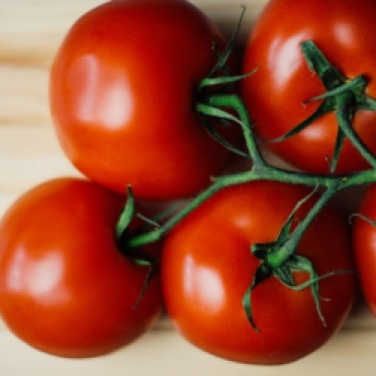



 Coffee
Coffee  A word about
A word about  Of note,
Of note, 








